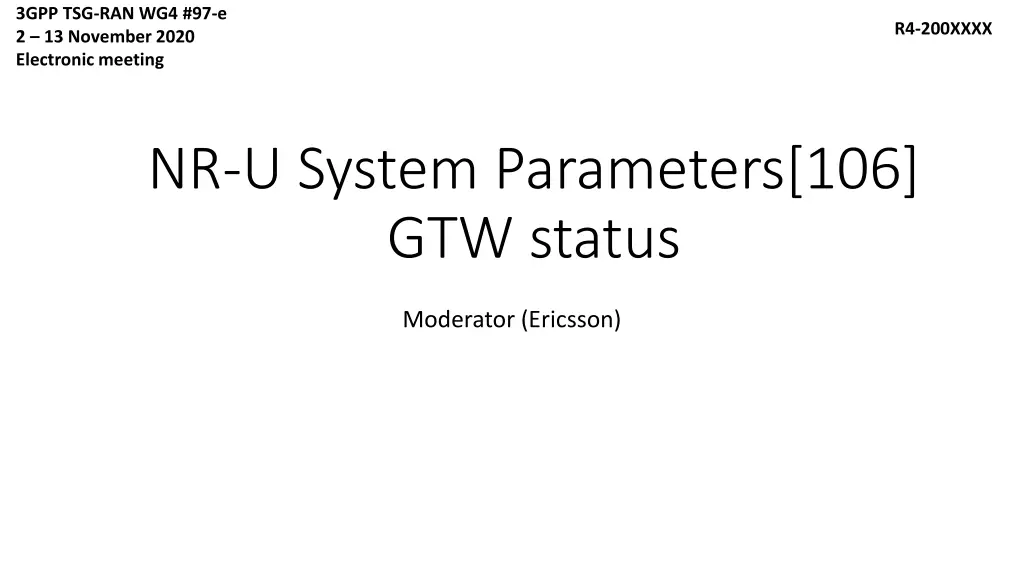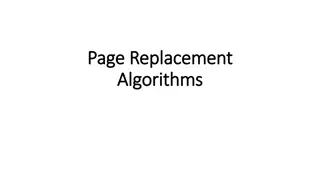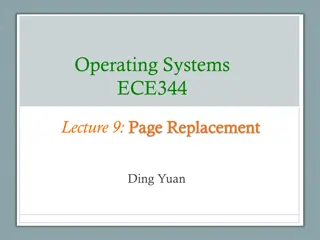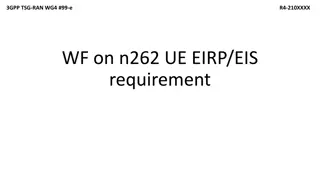
NR-U System Parameters and Wideband Operation Issues
Explore the latest discussions on UL and DL wideband operation proposals, UE capabilities, and FCC requirements for NR-U systems, including spectrum utilization, channelization, and wideband operation topics.
Download Presentation

Please find below an Image/Link to download the presentation.
The content on the website is provided AS IS for your information and personal use only. It may not be sold, licensed, or shared on other websites without obtaining consent from the author. If you encounter any issues during the download, it is possible that the publisher has removed the file from their server.
You are allowed to download the files provided on this website for personal or commercial use, subject to the condition that they are used lawfully. All files are the property of their respective owners.
The content on the website is provided AS IS for your information and personal use only. It may not be sold, licensed, or shared on other websites without obtaining consent from the author.
E N D
Presentation Transcript
3GPP TSG-RAN WG4 #97-e 2 13 November 2020 Electronic meeting R4-200XXXX NR-U System Parameters[106] GTW status Moderator (Ericsson)
Background Remaining Open Topics: Topic #1: Spectrum Utilization and channelization Topic #2: Wideband Operation Topic #3: NR-U CA BW Classes
UL Wideband operation Issue : Wideband Operation Proposals Option 1: wide-band transmission mode 1 assumes that LBT is successful in all LBT sub-bands of BWP, irrespective of which sub-bands are scheduled with data. (MediaTek) Option 2: A UE should perform LBT only for those sub-bands where data is scheduled. Then UL wide-band mode 1 is not needed as the UE behaviour will always correspond to UL mode 2A/2B (Apple) Agreement: A UE should perform LBT only for those sub-bands where data is scheduled. Issue : UE capabilities for UL wideband operation. Proposals Option 1: For UL WB operation, only Mode 1 is introduced as a basic feature, while Mode 2A and 2B should be removed according to Section 4.2.1.0.4 of TS 37.213. (MediaTek) Option 2: If Option 2 above is adopted, it is preferable to have differentiation between 2A and 2B accounting for different UE LBT capabilities. (Apple, Ericsson) Option 3: From a RAN4 perspective, none of the feature groups is needed for Rel-16 since requirements are not available or the feature group is already part of the baseline assumption that all UE s are expected to support. (Qualcomm, LGE, Huawei, Nokia) Agreement: From RAN4 perspective, no UL capability is needed assuming the max. UL channel bandwidth is 80MHz and UL TX is contiguous for Rel-16.
DL wideband operation Issue: DL wide-band mode 1 UE performance requirements apply only if sub-bands of the configured channel contain serving gNB transmission.(Apple) Proposals Option 1: Agreeable Option 2: Not agreeable Agreement: TBD Issue: UE capabilities for DL wideband operation. Proposals Option 1: There is no difference in UE capability between DL Cases 2a/2b/3 and DL Case 4. No UE capabilities are needed for DL wideband operation in addition to FG 4-1.(Nokia, LGE) Option 2: From a RAN4 perspective, none of the feature groups is needed for Rel-16 since requirements are not available or the feature group is already part of the baseline assumption that all UE s are expected to support. (Qualcomm) Option 3: (Apple, MediaTek) Proposal 1a: DL wide-band mode 1 can be construed as the baseline NR-U functionality. Proposal 1b: DL wide-band mode 2 and 3 must be differentiated from mode 1. Proposal 1c: Discuss further whether DL mode 2 and 3 should have separate capabilities or they can be covered by the same "mode 2/3" capability or they can be optional capabilities Agreement: UE support of DL wide-band mode 1 is mandatory. FFS whether a feature group needs to be specified for support of mode 1 FFS UE support of mode 2 and 3
FCC Requirements Issue : Based on FCC report, for different U-NII-bands, there are different EIRP limit and different usage policy from regulator e.g. AFC or non-AFC, therefore it is necessary for further discuss how to apply the requirements and AFC policy for those carries across the U-NII bands. (ZTE) Agreement: TBD Issue : It is very challenging to achieve the required attenuation for lower edge and upper edge of 6GHz assuming - 27dBm/MHz emission limit needed out of 6GHz band in FCC report. (ZTE) How to achieve emission limit -27dBm/MHz required by FCC? Proposals o Option 1: lower the BS output power o Option 2: reserve more guard band o Option 3: reserve guard band and put the fitter within the 6GHz band o Option 4: other proposals Agreement: TBD
NR-U System parameters SCS (kHz) 20 MHz NRB 24 251 Issue: Spectrum Utilization Proposals Option 1: Define both 24 and 25 PRB for 20 MHZ channel bandwidth for a UE supporting 60 kHz SCS. Option 2 : Define only 24 RBs for 20MHz channel bandwidth for a UE supporting 60 kHz SCS. 60 Note 1 It is only applied for Band n46 and n96. Agreements: TBD Issue: Intra-carrier guard band for 60kHz SCS Proposals Option 1: Adopt alternative 1 and 2 Option 2 : Adopt alternative 1 SCS 20MHz Channels 40MHz Channels 60MHz Channels 80MHz Channels Alt. 1 60KHz 24 [23-5-23] Max. 51 [23-5-23-5-23] Max. 79 [23-5-23-5-23-5-23] Max. 107 Alt. 2 60KHz [25] [24-3-24] Max. 51 [24-3-25-3-24] Max. 79 [24-4-24-3-24-4-24] Max. 107 Agreements: TBD
NR-ARFCN for band n96 Proposals Option 1: Remove Brackets from 38.101-1 Table 5.4.2.3-3 and TS 38.104 Table 5.4.2.3-1 in Note 2 values and Option 2: Revise 38.101-1 Table 5.4.2.3-3 and TS 38.104 Table 5.4.2.3-1 in Note 2 by adding NREF=873000 for 20 MHz channel bandwidth, NREF= {795668, 797000, 798332, 799668, 801000, 802332, 803668, 805000, 806332, 807668, 809000, 810332, 811668, 813000, 814332, 815668, 817000, 818332, 819668, 821000, 822332, 823668, 825000, 826332, 827668, 829000, 830332, 831668, 833000, 834332, 835668, 837000, 838332, 839668, 841000, 842332, 843668, 845000, 846332, 847668, 849000, 850332, 851668, 853000, 854332, 855668, 857000, 858332, 859668, 861000, 862332, 863668, 865000, 866332, 867668, 869000, 870332, 871668, 873000, 874332} for 40 MHz channel bandwidth, NREF= {797668, 800332, 803000, 805668, 808332, 811000, 813668, 816332, 819000, 821668, 824332, 827000, 829668, 832332, 835000, 837668, 840332, 843000, 845668, 848332, 851000, 853668, 856332, 859000, 861668, 864332, 867000, 869668, 872332} for 60 MHz channel bandwidth, NREF= {798332, 799668, 803668, 805000, 809000, 810332, 814332, 815668, 819668, 821000, 825000, 826332, 830332, 831668, 835668, 837000, 841000, 842332, 846332, 847668, 851668, 853000, 857000, 858332, 862332, 863668, 867668, 869000, 873000 } for 80 MHz channel bandwidth, NREF= {799000, 804332, 809668, 815000, 820332, 825668, 831000, 836332, 841668, 847000, 852332, 857668, 863000, 868332} Agreements: TBD
GSCN for band n96 GSCN for band n96 Proposals Option 1: Remove Brackets from 38.101-1 Note 4 in table 5.4.3.3-1 of TS 38.101-1 and Note 6 in table 5.4.3.3-1 of TS 38.104 Option 2: Revise Note 4 in table 5.4.3.3-1 of TS 38.101-1 and Note 6 in table 5.4.3.3-1 of TS 38.104 as below: GSCN = [9548, 9562, 95769575, 95909589, 9603, 9617, 9631, 9645, 9659, 9673, 9687, 97019700, 97159714, 9728, 9742, 9756, 9770, 9784, 9798, 9812, 9826, 9840, 9853, 9867, 9881, 9895, 9909, 9923, 9937, 99519950, 99659964, 9978, 9992, 10006, 10020, 10034, 10048, 10062, 1007610075, 1009010089, 10103, 10117, 10131, 10145, 10159, 10173, 10187, 1020110200, 1021510214, 10228, 10242, 10256, 10270, 10284, 10298, 10312, 1032610325, 1034010339, 10353] Agreements: TBD
NR-U CA BW Classes Issue: Merge NR-U CA configurations CA_n46G, CA_n46H, and CA_n46I into CA_n46M, n46N, and n46O respectively as shown in Table 2.2-2 in R4-2014889 (Apple) Proposals Option 1: Agreeable Option 2: Not agreeable NR CA configuration / Bandwidth combination set Channel bandwidths for carrier (MHz) (MHz) 20, 40 60, 80 80 80 80 80 40 40 40 40 40 40 20, 40 20, 40 20, 40 20, 40 20, 40 20, 40 Channel bandwidths for carrier (MHz) 20, 40, 60 60, 80 60, 80 80 40, 60 40, 80 60 20, 40, 60 20, 40, 80 20, 60 Channel bandwidths for carrier Channel bandwidths for carrier (MHz) Channel bandwidths for carrier (MHz) Maximum aggregated bandwidth (MHz) 100 160 240 320 140 200 220 60140 80200 100220 Uplink CA configurat ions Bandwidth combination set NR CA configuration CA_n46B CA_n46C CA_n46D CA_n46E CA_n46G CA_n46H CA_n46I CA_n46M CA_n46N CA_n46O - - - - - - - - - - 0 0 0 0 0 0 0 0 0 0 80 40 40 40 20, 40 20, 40 20, 40 Agreements: TBD
NR-U CA BW Classes Issue: Keep the description of FBG 3 for NR CA bandwidth classes D and E unchanged in the current specification as it is. (ZTE) Proposals Option 1: Agreeable Option 2: Not agreeable Fallback group 1, 3 NR CA bandwidth class D E Aggregated channel bandwidth 200 MHz < BWChannel_CA 3 x BWChannel,max 300 MHz < BWChannel_CA 4 x BWChannel,max Number of contiguous CC 3 4 Agreements: TBD Issue: Revise NR CA BW classes definition based on the following changes: Define the aggregated channel BW upper limits for classes M, N, and O as below: (Apple) Also the aggregated channel BW lower limits of classes M, N and O in current specifications should have the = sign (ZTE, Apple) Proposals Option 1: Agreeable Option 2: Not agreeable BW Class M N O Aggregated BW No. of CC 3 4 5 50 MHz BWChannel_CA 180200 MHz 80 MHz BWChannel_CA 240300 MHz 100 MHz BWChannel_CA 300400 MHz Agreements: TBD
NR-U CA BW Classes Issue: Remove CA BW class I from NR-U DL CA Rx requirements for ACS, in-band blocking, and out-of-band blocking as it can be covered by CA BW class O . (Apple) Proposals o Option 1: Agreeable o Option 2: Not agreeable Agreements: TBD Issue: It is suggested not to use notation N for NR CA BW class in FR1 since NR band number begins with the letter n , CA BW class N is absent in FR2 to avoid unnecessary confusion. (ZTE) Proposals o Option 1: Agreeable o Option 2: Not agreeable Agreements: TBD




